The path of on-chain cultural expansion behind the surge in ZORA prices
- 核心观点:Base与Zora推动链上内容代币化变革。
- 关键要素:
- Base日代币发行量超Solana。
- Zora代币30天内上涨600%。
- 创作者已获超3500ETH奖励。
- 市场影响:推动创作者经济与SocialFi发展。
- 时效性标注:中期影响。
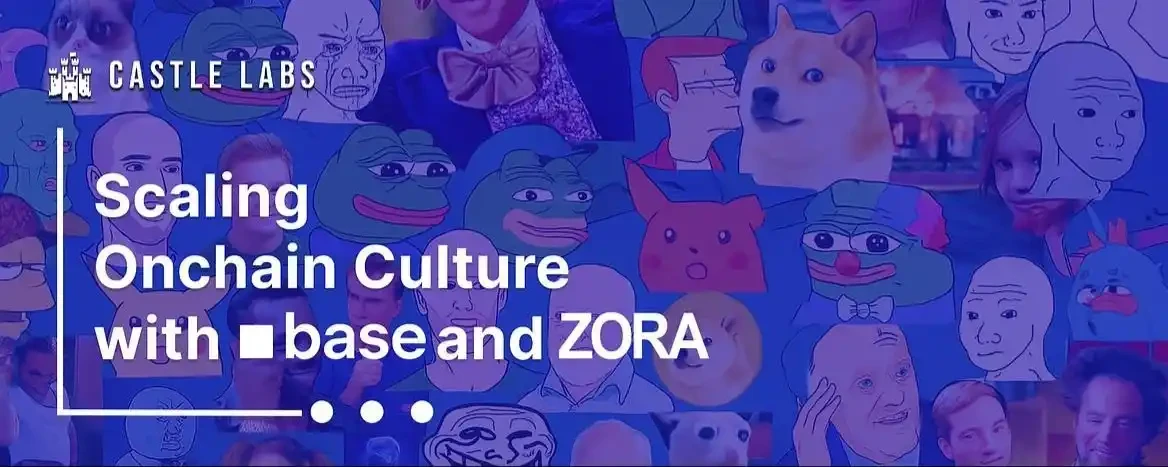
Original Title: Scaling Onchain Culture with Base and Zora
Original article by @sakshimiishra, Castle Labs
Original translation: BlockBeats
Editor’s Note: Coinbase CEO Brian Armstrong’s purchase of Balaji’s creator tokens on the Zora platform has once again fueled market enthusiasm for Zora and content tokens.
The Zora network's fundamentals are strong, with its token price stabilizing in the $0.115–$0.12 range and high on-chain content creation and distribution activity. Driven by Base app integration and resurgent market interest, Zora's potential as a core testing ground for the "content economy" is further underscored. Below, we will delve into the recent developments of Zora and Base from three perspectives: market trends, on-chain activity, and ecosystem evolution.

In the past year, the Layer 2 track has been highly competitive, but Base has successfully broken through, not only attracting more than US$4.9 billion in locked-in volume, but also giving birth to a rich DeFi, NFT and rapidly growing SocialFi application ecosystem.
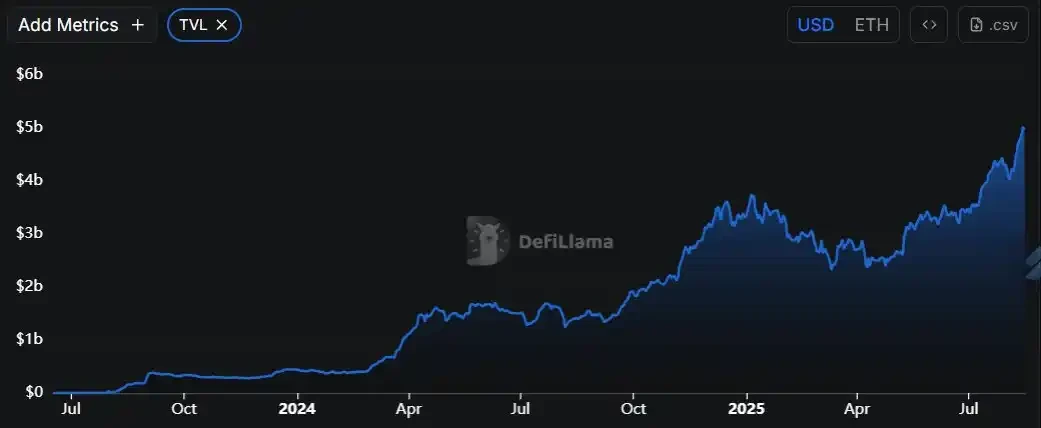
However, for Base, TVL is just the tip of the iceberg. Its focus is actually "crypto culture."
This strategy is showing results, with the number of tokens issued on Base recently surpassing Solana, largely due to Coinbase's rebranding of its wallet as the Base App, a crypto "super app" for the creator economy.
Through deep integration with SocialFi platforms such as @Farcaster_xyz, @Zora, and @Clankeronbase, as well as mini-apps such as @noicedotso, Base App transforms social content into tradable on-chain assets, reshaping the way creators monetize and the community interacts.
This is the path of on-chain cultural expansion that Base and Zora are jointly promoting.
A Brief History of Base
Base is a second-layer blockchain built by Coinbase based on Optimism's OP Stack, with the goal of making Ethereum faster, cheaper, and easier to use.
As of mid-2025, Base has achieved:
24.4 million monthly active addresses
Peak 161.92 TPS
Over 276 million transactions in the past 30 days, far exceeding most L2
An active ecosystem consisting of DeFi, NFT, and SocialFi projects
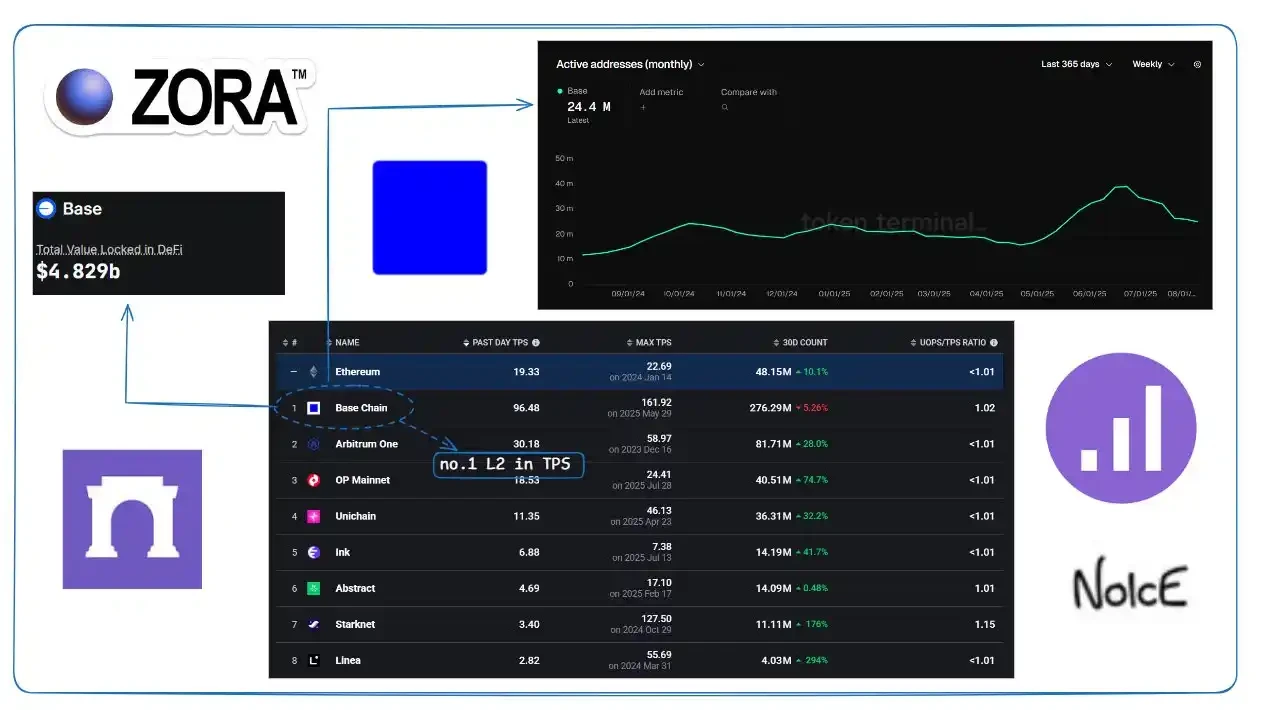
In addition, events like "Base Onchain Summer" further demonstrate that Base not only wants to scale Ethereum, but also wants to lay the infrastructure for millions of creators and communities to enter Web 3.
Base App: From Infrastructure to Cultural Center
As Base evolved from simple blockchain infrastructure to a cultural hub, it placed the creator economy at its core. The launch of the new Base app in July 2025 marked more than just a rebranding effort; it also marked Coinbase's evolution from single-chain support to a comprehensive ecosystem empowering developers, creators, and everyday users worldwide, allowing them to monetize and own their work directly on-chain.
Coinbase’s vision for the Base App is clear: to create a “super app” for the crypto world.
The core features of the Base App include:
· wallet
Social dynamics
Payment
Mini apps
AI assistant
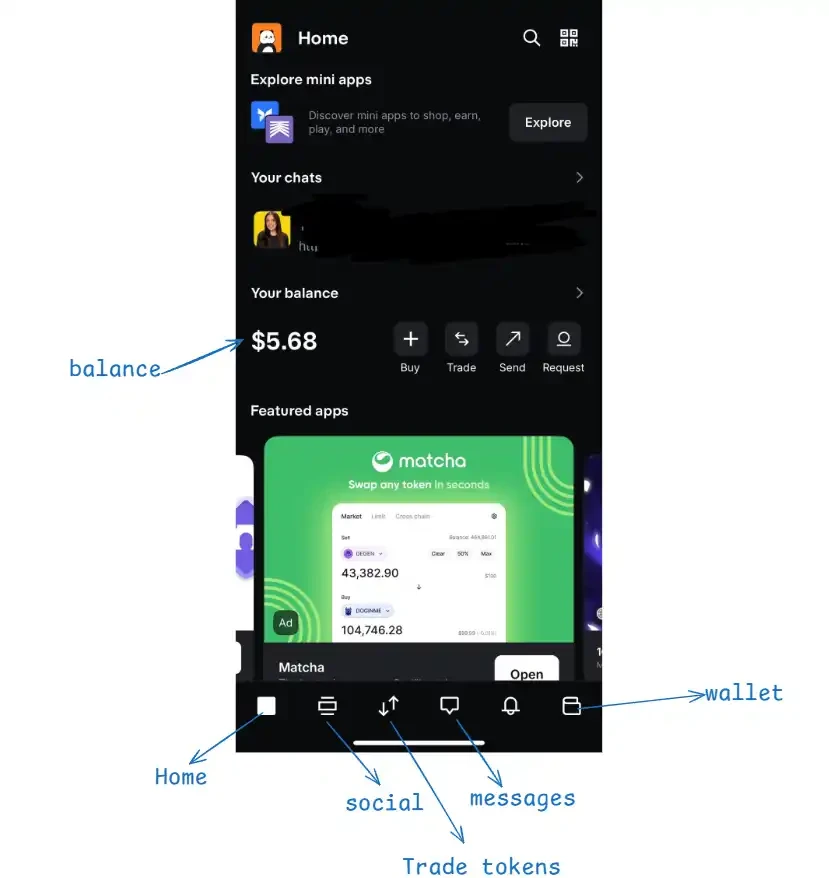
Think of it like Apple Pay combined with decentralized social media. Once a user logs in, the system automatically generates a smart wallet, eliminating the need for tedious mnemonic phrase backups.
What is a Smart Wallet?
Smart Wallet is a self-hosted, on-chain wallet based on Passkey, embedded directly into the app, and features a "no-brainer" experience. No browser plugins or frequent app switching required, making the overall experience much smoother.
The real highlight of Base is its SocialFi integration. By embedding platforms such as Zora and Farcaster, Base is trying to break the control of traditional Web 2 platforms on creators and let them truly own their own content.
The flaws of the Web 2 creator economy
In the Web 2 world, creators face difficult choices:
- Subscription model: requires continuous output, lacks human touch, and locks content behind a paywall.
- Advertising: It only makes sense when there is a huge audience, but it seriously affects the user experience.
- Rewards: scattered and unsustainable, it is difficult to support long-term creation.
To make matters worse, the platform economy is heavily skewed in favor of the platforms. As shown in the chart below , platforms like TikTok, Instagram, and X capture 85-95% of the value, leaving only 5-15% for creators. Even with YouTube's relatively "better" 55/45 split, nearly half of the revenue still goes to the platform.
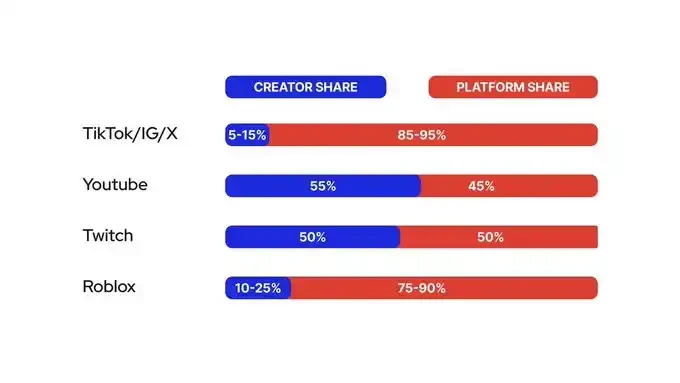
This serious imbalance is exactly what Base's new SocialFi strategy aims to change. The social layer runs on Farcaster, and posts can be instantly minted into tradable ERC 20 tokens through Zora.
Content tokenization is a simple yet powerful idea.
Every post, image, or video can be minted into a tradable ERC-20 token called a Content Coin. This transforms social media interactions into liquid, ownable assets, creating new monetization methods for creators and allowing fans to directly participate in the success of their content.

In addition to direct transactions, mini-apps like Noice also support tipping.
As of now, the amount of tips on Noice has exceeded 250,000 US dollars , becoming another source of income for creators.
Creators can also earn money in the following ways:
- Content coin transaction fee (0.5%)
- Retain 1% of the content currency share and can sell it at your own discretion
- Weekly reward distribution: For example, at the end of July, the Base App distributed $10,000 USDC to more than 2,900 accounts.
Base's creator reward mechanism
On the Base app, every post is minted into a "Content Coin," with a fixed supply of 1 billion. Of these, 10 million (1% of the total supply) are allocated directly to creators, giving them ownership from the start and allowing them to profit when their content becomes popular. Meanwhile, there's also a "Creator Coin," which is tied to a person's profile and serves as a tradable asset, representing the creator's value.
The entire incentive model is written into the smart contract and automatically executed through fee sharing. All content currency transactions are charged a 1% fee , of which:
- 0.5% goes to creators
- 0.3% goes to referrers (0.15% goes to transaction referrers, 0.15% goes to content creation referrers)
- 0.2% goes to the Zora Protocol
To date, this mechanism has brought more than 3,500 ETH in rewards to creators.
Creator Coins are traded through the Uniswap V3 pool, allowing users to buy and sell instantly. However, insufficient liquidity remains a challenge for many small and medium-sized creators. Compared to traditional platforms (such as X, which take over 85% of revenue), Zora's system allows creators to retain over 50% of the value and offers additional profit opportunities.
What sets Zora apart from previous attempts is its "content-first" approach. Rather than simply turning creators into "meme coins," Zora tokens are directly tied to the content they create, such as images, text, or videos. When a creator uploads an image, they can name the corresponding token, making it directly reflect the content itself. This design allows the token's value to transcend mere hype and become more intrinsic, closely tied to the creator's expression.
Some of the apps that Base App has integrated include:
- Zora: This platform offers content tokenization, allowing users to convert social media posts (e.g., text, images, and videos) into tradable ERC-20 "content tokens" that are automatically connected to Uniswap liquidity pools. Creators receive 10 million tokens per post and receive a 1% share of transaction fees, making Zora a hub for content creation and monetization.
- Farcaster: As a social infrastructure, it provides a decentralized user interaction protocol, including posting and commenting. It integrates with the Base App to provide a platform for sharing and interacting with tokenized content.
- Clanker: An AI-powered tool for rapidly issuing meme tokens through Farcaster. Users can create ERC-20 tokens on Base by simply tagging @clanker on Farcaster, and leverage its social integration to drive community-based token discovery and deployment.
- Noice: A Farcaster mini-app focused on tipping and interaction, it serves as a traffic gateway for the Farcaster economy. It boosts user engagement through content tipping, complementing Zora's tokenization capabilities and Farcaster's social layer. Noice's influence was highlighted by its founder's presence at the Base TBA conference.
How they work together:
- The Base App combines Zora’s tokenization technology with Farcaster’s social protocol, allowing users to create, share, and trade tokenized content.
- Clanker simplifies the token creation process through Farcaster’s social channels, while Noice enhances interaction through a tipping feature.
This combined effect drives the formation of network effects, continuously attracting creators and traders to join.
Base App as a catalyst for ZORA
The integration of the Base app and Zora has driven a surge in ZORA's price and on-chain activity, with significant increases in both trading volume and the number of active creators. This momentum is also driven by the skillful operation of the community. Led by Base founder Jesse Pollak, coordinated Farcaster promotion and grassroots buzz marketing have attracted thousands of new creators and traders.
The data speaks for itself:
- Zora’s daily active independent creator count soared from 2,000 on July 16, 2025 (the day before the Base App was released) to 22,500 on July 27.
- ZORA has surged 600% in the past 30 days, with its listing on Binance bringing increased visibility and liquidity. Its all-time high price reached $0.14, a 1,400% increase.
- On August 4, the token issuance on Base was 51,575, surpassing Solana's Pump.fun (only 4,173). This is the first time since the beginning of 2023 that a chain has surpassed Solana in daily token issuance .
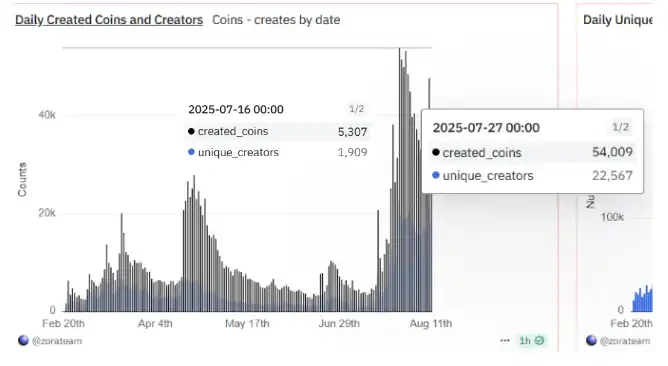
Coinbase’s brand and influence are also amplifying Zora’s growth. From CEO Brian Armstrong’s “Base Shake” meme coin to Pollak’s frequent appearances on Farcaster, the community continues to have reasons to “create, trade, and participate.”
Risks: Hype, speculation, and model limitations
As mentioned earlier, creators have four main ways to make money, including selling their 1% allocated content tokens, but this has also raised many questions, the most common of which is the sustainability issue. Is this platform building a long-term creator economy, or is it just another speculative paradise?
In April 2025, Zora airdropped 1 billion tokens to 2.4 million wallets. While intended to celebrate growth, many tokens were worth less than their gas fees and had no governance functionality. Critics called it "just for fun" and argued it distracted from long-term value creation.
Its token distribution has also attracted attention:
- 38.9% Team/Treasury
- 26.1% Investors
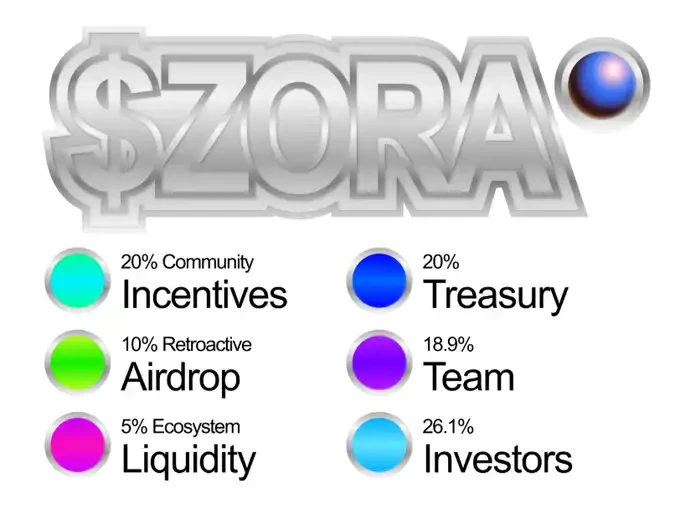
This highly concentrated coin holding structure raises concerns about centralization, especially for a platform that claims to empower creators.
There has been a lot of debate surrounding the sustainability of the Base App's economic model.
One criticism describes Zora as a "super casino-like purgatory," arguing that Content Coin is more like a meme coin with no intrinsic value, whose transactions rely more on social media buzz than genuine content engagement. Within this zero-sum framework, Zora is less a tool for creators and more a short-term speculative game.
After all, the creator model has appeared in the NFT era and mostly ended in failure.
During this period, Solana co-founder Toly and Base founder @Jessepollak also had a heated discussion publicly on X.
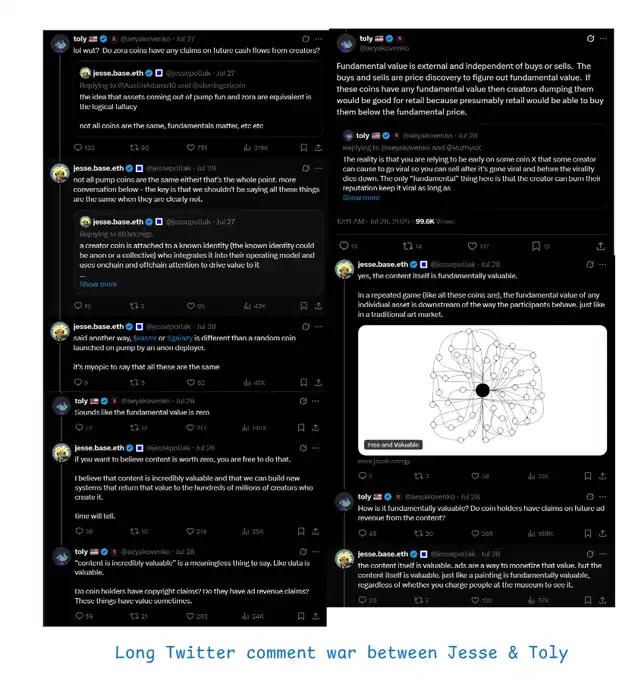
This "philosophical" debate can be summarized as follows:
Toly's View
- Toly questioned the value of Zora’s tokenization of social media posts, even asking sarcastically: “lol wut? Can the tokens on Zora share in the creators’ future cash flow?” He called these tokens “digital garbage” and compared them to speculative NFTs or mobile game blind boxes.
- He believes that Zora tokens lack fundamental value because they do not give holders any rights to creators' future income (such as advertising revenue) and their value is entirely based on speculation.
- Toly even suggested that if Jesse truly believed in its intrinsic value, Coinbase should buy these "almost worthless" tokens to prove their financial utility.
Jesse's response
- Jesse emphasized that content itself has intrinsic value, much like art, and shouldn't be measured solely by immediate monetization. He argued that Zora's token, through integration with the Base App, could redistribute value to creators, with its fundamentals tied to the activity of creators.
- He described Zora as an “infinite game” where community-driven actions continuously create systemic value, rather than just speculative trading, thereby empowering millions of creators.
User reactions are divided
- Some have criticized Toly’s stance as hypocritical, given that Solana itself is obsessed with the meme coin narrative.
- Some also see this as a battle of blockchain concepts: Base emphasizes the creator economy, while Solana is more inclined towards the speculative market.
However, beyond the philosophical debate, the Base App itself also exposes some issues worthy of attention:
- Trading volume plummeted: Trading volume fell sharply in the first week of August, dropping from a peak of $550 million to $77 million (source: TokenTerminal ).
- Lack of transparency: Issues including suspected insider wallet transactions and opaque information disclosure have severely undermined trust. Zora's "Ethos" page has also received negative reviews, further affecting community sentiment.
- Poor user experience: Users generally complain that the Base App’s posting speed is very slow, which brings a poor user experience.
- Content regulation controversy: Last week, the top of the Base platform's token list was a pornographic website, which sparked a lot of criticism (Source: Decrypt ).
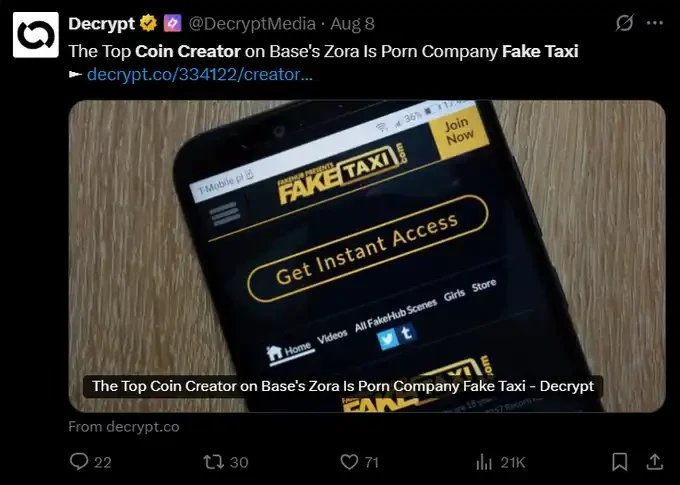
However, supporters believe that this is just a necessary cycle for any hit product. At least for now, their judgment is not unreasonable: in the second week of August, ZORA's market accelerated again.
Trading volume, which had declined within a few days, quickly rebounded in the second week.
Smart money and large investors began to pour in, pushing ZORA up 46% in a single day, setting a record high of $0.14.
The platform's recent iterations are also continuing, including "all-round acceleration" and performance improvements on the Android side.
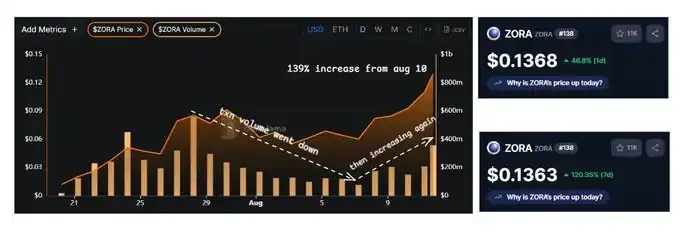
The real question then becomes: Can Zora’s model transcend speculation, build long-term trust, and achieve scale without diluting its core narrative of on-chain creator ownership? Or will it ultimately be seen as just another rebranded meme coin platform?
Future Path and Imagination Space
Despite the ongoing controversy, Zora is still in its early stages, but has the potential to reshape the value system and monetization logic of digital content.
Currently, it has gathered over 421,000 creators and nearly 3 million collectors , and has achieved seamless expansion based on Base's OP Stack. Combined with Coinbase's massive user base , its future penetration potential cannot be underestimated.
Several developments worth noting include:
- Deeper integration with Farcaster strengthens the integrated interaction of "social + economy".
- Launched Coins SDK to lower the threshold for developers to build on the Content Coin model.
- Prioritize mobile expansion for global markets and enter regions where creators have not yet fully monetized.
Conclusion: A new layer of on-chain culture?
Base initially served as a faster, cheaper Ethereum Layer 2 technology solution. However, as the Base app evolved, it shifted to a broader purpose: an economic layer for culture, creativity, and community. Through this reinvention, Coinbase clearly signaled its transition from a centralized exchange to a more decentralized Web 3 infrastructure.
Base's market strategy is clear: build infrastructure → attract creators → allow on-chain culture to compound. Zora plays a central role in this: turning content into tokens and creators into stakeholders.
Risks remain. The hype will eventually fade, and building trust takes time. While the speculative nature of content tokens may attract some, it can also deter others. Centralized token distribution and transparency issues are also issues that must be addressed.
However, if Zora and Base can refine their models, improve the user experience, and achieve better alignment of incentives, they do have a chance to reshape digital ownership.
The unanswered question is: Will content tokens be the next evolution in creator monetization, or will they ultimately be just another experiment in crypto’s long history of hype?



